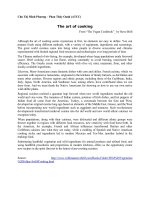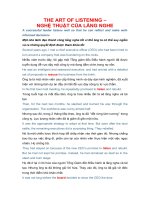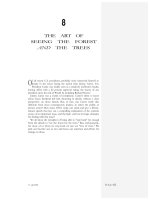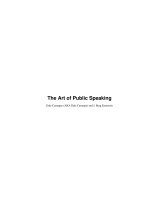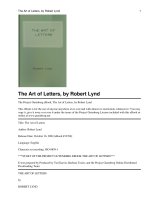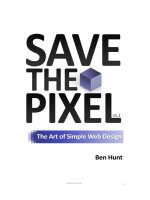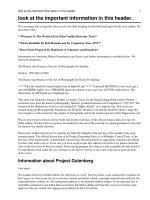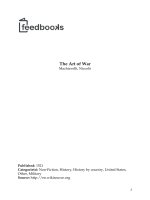The art of what works. How success really happens (2003)
Bạn đang xem bản rút gọn của tài liệu. Xem và tải ngay bản đầy đủ của tài liệu tại đây (1.2 MB, 304 trang )
The Art of
What Works
00 FM Duggan 6/11/03 3:59 PM Page i
This page intentionally left blank.
The Art of
What Works
How Success Really Happens
William Duggan
McGraw-Hill
New York Chicago San Francisco
Lisbon London Madrid Mexico City
Milan New Delhi San Juan Seoul
Singapore Sydney Toronto
00 FM Duggan 6/11/03 3:59 PM Page iii
Copyright © 2003 by William Duggan. All rights reserved. Manufactured in the United States of
America. Except as permitted under the United States Copyright Act of 1976, no part of this publication
may be reproduced or distributed in any form or by any means, or stored in a database or retrieval
system, without the prior written permission of the publisher.
0-07-143350-3
The material in this eBook also appears in the print version of this title: 0-07-141206-9
All trademarks are trademarks of their respective owners. Rather than put a trademark symbol after
every occurrence of a trademarked name, we use names in an editorial fashion only, and to the benefit
of the trademark owner, with no intention of infringement of the trademark. Where such designations
appear in this book, they have been printed with initial caps.
McGraw-Hill eBooks are available at special quantity discounts to use as premiums and sales pro-
motions, or for use in corporate training programs. For more information, please contact George
Hoare, Special Sales, at or (212) 904-4069.
TERMS OF USE
This is a copyrighted work and The McGraw-Hill Companies, Inc. (“McGraw-Hill”) and its licensors
reserve all rights in and to the work. Use of this work is subject to these terms. Except as permitted
under the Copyright Act of 1976 and the right to store and retrieve one copy of the work, you may not
decompile, disassemble, reverse engineer, reproduce, modify, create derivative works based upon,
transmit, distribute, disseminate, sell, publish or sublicense the work or any part of it without
McGraw-Hill’s prior consent. You may use the work for your own noncommercial and personal use;
any other use of the work is strictly prohibited. Your right to use the work may be terminated if you
fail to comply with these terms.
THE WORK IS PROVIDED “AS IS”. McGRAW-HILLAND ITS LICENSORS MAKE NO GUAR-
ANTEES OR WARRANTIES AS TO THE ACCURACY, ADEQUACY OR COMPLETENESS OF
OR RESULTS TO BE OBTAINED FROM USING THE WORK, INCLUDING ANY INFORMA-
TION THAT CAN BE ACCESSED THROUGH THE WORK VIA HYPERLINK OR OTHERWISE,
AND EXPRESSLY DISCLAIM ANY WARRANTY, EXPRESS OR IMPLIED, INCLUDING BUT
NOT LIMITED TO IMPLIED WARRANTIES OF MERCHANTABILITY OR FITNESS FOR A
PARTICULAR PURPOSE. McGraw-Hill and its licensors do not warrant or guarantee that the func-
tions contained in the work will meet your requirements or that its operation will be uninterrupted or
error free. Neither McGraw-Hill nor its licensors shall be liable to you or anyone else for any inac-
curacy, error or omission, regardless of cause, in the work or for any damages resulting therefrom.
McGraw-Hill has no responsibility for the content of any information accessed through the work.
Under no circumstances shall McGraw-Hill and/or its licensors be liable for any indirect, incidental,
special, punitive, consequential or similar damages that result from the use of or inability to use the
work, even if any of them has been advised of the possibility of such damages. This limitation of lia-
bility shall apply to any claim or cause whatsoever whether such claim or cause arises in contract, tort
or otherwise.
DOI: 10.1036/0071433503
ebook_copyright 8.5 x 11.qxd 8/12/03 11:58 AM Page 1
Contents
v
Preface vii
Part 1 The Art of Expert Intuition 1
Chapter 1 Introduction 3
Chapter 2 An Eye for What Works 13
The Problem of Intuition 13
Goal Setting versus Coup d’Oeil 16
Four Keys to Success 22
Coup d’Oeil Today 26
Coup d’Oeil in Science 30
East Meets West 35
An Eye for Business 41
Chapter 3
The Art of Success 43
Adaptive versus Creative Response 43
Creative Imitation 48
Build on What Works 51
Johnson & Johnson 53
Marriott 53
American Express 54
Creative Structure 58
DuPont 60
00 FM Duggan 6/11/03 3:59 PM Page v
For more information about this title, click here.
Copyright 2003 by William Duggan. Click Here for Terms of Use.
General Motors 61
Standard Oil 64
Sears 66
The Art of Japanese Business 68
The GE Way 72
The Erratic Goddess 76
Creative Success 80
Part II The Advantage of Expert Intuition 83
Chapter 4 Plan-to versus Can-do 85
The Triumph of Planning 85
Strategic Flexibility 90
Honda Takes Off 94
What’s a Good Plan? 97
Coastline Pool Consortium 98
Strategic Intent 101
Core Competence 104
Creative Planning 106
Chapter 5
Change versus Charge 109
The Fifth Discipline 109
Great Groups 113
Knowledge Management 119
The Achievement Network 121
Organizational Change 125
Chapter 6
Forces versus Sources 129
Five Forces and Three Strategies 129
Does It Work? 134
Competitive Intuition 138
Grounded Research 140
Five Sources 144
Competitive Insight 145
Expert Analysis 147
Part III The Application of Expert Intuition 149
Chapter 7 Arrows in the Quiver 151
Brainstorming 152
Is It SMART? 155
vi CONTENTS
00 FM Duggan 6/11/03 3:59 PM Page vi
SWOT 156
Creative Stimulation 157
Bootstrapping 161
Normal Science 165
What-Works Scan 167
Wei Wu Wei 171
Quality 173
Dialogue 176
Reengineering 178
Game Theory 181
Trotter Matrix 183
S-Curve 185
After-Action Review 187
Chapter 8
The Art of Synthesis 193
Whose Strategy Is It? 194
The McKinsey Way 196
Strategic Synthesis 206
Chapter 9
The Way of What Works 211
In Search of Success 215
Let Go 220
The Hero’s Journey 224
Creative Strategy 229
Appendix
Right versus Might 233
Schools of Social Strategy 234
In Search of What Works 236
GRAD 238
Globe-Trotter 242
Notes 351
Index 271
Contents vii
00 FM Duggan 6/11/03 3:59 PM Page vii
This page intentionally left blank.
Preface
ix
LEONARDO DA V INCI, the original “Renaissance man,”
stands out in history for his achievements in both science and art.
He made scientific advances, especially in anatomy and mechani-
cal invention, and he painted two of the most famous pictures of
all time: the Mona Lisa and the Last Supper.
How did he do it?
A famous quote by Leonardo himself reveals the secret:
As you cannot do what you want,
want what you can do.
1
Leonardo da Vinci was an artist of what works.
He tells us that his creative method starts by giving up “what
you want.” This contradicts conventional wisdom: Doesn’t every-
thing start with a vision, a goal, a desire? According to Leonardo,
no. You have to give those up. Instead, you “want what you can
do.” That is, first you see what you can do, then you know what
goal to set. You don’t know what problem you can solve, what
00 FM Duggan 6/11/03 3:59 PM Page ix
Copyright 2003 by William Duggan. Click Here for Terms of Use.
painting to paint, what desire to fulfill, until you see how to do it.
You do what you can, not what you want.
But still we ask: What can you do?
That depends on how much you know, how much you’ve
learned, and what skills you master. You can only do what you or
someone else has done in the past, but in new combinations to
suit the present. The more you study the experience of others, and
the more you practice yourself, the more you can do. What works
in the future is some combination of what worked before in the
past. Great scientists, great artists, great business leaders—they
don’t “reach for the stars,” they grasp what works.
Four centuries later, we hear an echo of Leonardo’s secret in
the words of a modern Renaissance man:
The operative assumption today is that someone, somewhere, has
a better idea; and the operative compulsion is to find out who has
that better idea, learn it, and put it into action—-fast.
2
This quote comes from Jack Welch, who rivaled Leonardo in
the range of his achievements. Welch ran General Electric, the
world’s largest conglomerate, for 20 years of stunning success,
from 1981 to 2001. At a time when other companies sought greater
focus on one or two major businesses, Welch succeeded in a
dozen different sectors, from aircraft engines to mortgage insur-
ance to a major television network.
For Welch, a good idea was something that worked before
somewhere else. You search for what works, and that tells you
what you can do. Then you go ahead and do it. As Welch saw it,
his main job was to spread this method through General Electric’s
many different companies. Contrast that with the dot.com craze
of the same era, where pie-in-the-sky business plans brought the
stock market to its knees. Like Leonardo da Vinci, Welch was an
artist of what works.
This book tells how Leonardo and Jack Welch did it. And not
just them: We find dozens of others throughout the ages. Napo-
leon Bonaparte, Bill Gates of Microsoft, Ray Kroc of McDonald’s,
and top companies like Nokia, Marriott, Johnson & Johnson—the
x PREFACE
00 FM Duggan 6/11/03 3:59 PM Page x
list goes on and on. The art of what works is the secret of strategy,
a timeless truth for success in business or any other field.
This book presents principles, tools, and examples to help you
apply the art of what works yourself. We study success, to see how
it happened. Our trail leads mostly through business strategy, but
it leads also to science, art, war, government, the nonprofit sector,
psychology, and Eastern and Western philosophy. We hunt for suc-
cess from many angles. Time and again, in case after case, the
answer turns out to be the same: the art of what works.
But how can success be the same? Every sector is different.
Every business is different. Every year something changes. Don’t
we miss key factors by looking at what is the same?
Yes, every situation is unique. But every situation is made up
of elements that are similar to something in the past. The combi-
nation is new, but the elements are not. In the art of what works,
the answer is always different, but the question is always the
same: What past successes can I draw from and combine in this
new situation? The more you learn and the more you study past
achievements, the more likely it is that a new situation will look
familiar, and the greater your chance of success.
Certainly there are differences among successful strategies, but
much is gained from studying what is the same. The structure of
every success looks alike, although the content changes from case
to case. Such is the art of what works.
We can see a close parallel in yet another field: mythology.
In his landmark study The Hero with a Thousand Faces, Joseph
Campbell describes a common “hero’s journey” in myths across
the globe:
A hero ventures forth from the world of common day into a
world of supernatural wonder: fabulous forces are there encoun-
tered and a decisive victory is won: the hero comes back from this
mysterious adventure with the power to bestow boons on his fel-
low man.
3
There are countless myths in the world, but only one hero’s
journey. So too with success: Amid great variety, you find the
Preface xi
00 FM Duggan 6/11/03 3:59 PM Page xi
same story again and again. Furthermore, we will find that our
strategists see what to do not in bits and pieces but all at once, in
a flash of insight that starts them off on a hero’s journey of the sort
that Campbell describes.
There are many, many artists of what works—or perhaps, as
Campbell might claim, there is only one, with a thousand faces
depending on the situation and times.
Maybe one of these faces is you.
xii PREFACE
00 FM Duggan 6/11/03 3:59 PM Page xii
The Art of
What Works
00 FM Duggan 6/11/03 3:59 PM Page xiii
This page intentionally left blank.
PART
I
The Art
of Expert
Intuition
01 Chap Duggan 6/11/03 3:36 PM Page 1
Copyright 2003 by William Duggan. Click Here for Terms of Use.
This page intentionally left blank.
CHAPTER
1
Introduction
The Problem of Strategy
3
IN 2001, the Nobel Prize in economics went to Joseph Stiglitz,
George Akerlof, and Michael Spence for showing how and why
markets again and again fall prey to imperfect information. Stiglitz
explains their main idea:
In the field of economics, perhaps the most important break with
the past—one that leaves open huge areas for future work—lies
in the economics of information. It is now recognized that infor-
mation is imperfect, obtaining information can be costly, there are
important asymmetries of information, and the extent of informa-
tion asymmetries is affected by actions of firms and individuals.
1
What this means for business strategy is that you can never
predict the future, no matter how hard you try. You can gather
more and more data and analyze them night and day, but you
still can’t know which strategy will work and which will not.
Whatever you do, your information remains imperfect. It will not
yield an answer to what your strategy should be.
Does this mean that we just give up? Is strategy a problem we
just can’t solve?
01 Chap Duggan 6/11/03 3:36 PM Page 3
Copyright 2003 by William Duggan. Click Here for Terms of Use.
Not quite. There is an answer. It’s just very different from what
we expect. And it’s been around for a very long time, since the
first full scholarly study of strategy more than a century and a
half ago.
That study is On War by Carl von Clausewitz, published in
1832.
2
Strategy began as a military science, and over the years
it spread to other fields, especially business. Although military
strategy goes back in time as long as war has existed, the schol-
arly study of strategy starts with von Clausewitz. The word strat-
egy entered the English language only in 1810, at the height of
Napoleon Bonaparte’s military success.
3
Napoleon won more bat-
tles than any other general in history, before or since. On War
explains how he did it.
Von Clausewitz uses a vivid term for imperfect information:
the “fog” of war.
The great uncertainty of all data in War is a peculiar difficulty,
because all action must, to a certain extent, be planned in a mere
twilight, which in addition not unfrequently—like the effect of
fog or moonshine—gives to things exaggerated dimensions and
an unnatural appearance.
According to von Clausewitz, four key elements of strategy
will help you make it through this fog of uncertainty.
First, you enter the fog with “presence of mind”—you expect
the unexpected. Don’t go in thinking that you already know what
to do. Be ready for surprise.
Second, you cut through the fog in a flash of insight. That flash
is a coup d’oeil,* which is French for “glance.” To von Clausewitz, a
coup d’oeil is “the rapid discovery of a truth which in the ordi-
nary mind is either not visible at all or only becomes so after long
examination and reflection.”
Third, a strategist follows through on the coup d’oeil with
“resolution.” To von Clausewitz, resolution is “removing the tor-
ments of doubt when there are no sufficient motives for guid-
ance.” There is no way to prove that your coup d’oeil is right, to
4 THE ART OF EXPERT INTUITION
*Pronounced “koo-DOY.”
01 Chap Duggan 6/11/03 3:36 PM Page 4
convince every doubter with facts and figures. Despite the
doubts, you follow through.
Fourth, the doubts are much reduced when “strategy . . . turns
to experience, and directs its attention on those combinations
which military history can furnish.” These combinations are the
very content of the actual coup d’oeil. You see in a flash a new
combination based on what worked in the past.
Presence of mind, coup d’oeil, resolution, and combinations
from history—these four elements were the secrets of Napoleon’s
success. To von Clausewitz, they formed the essence of strategy
that others could also use.
Today, more than a century after von Clausewitz, modern
research has given these four elements a growing body of scien-
tific support, plus a modern name: expert intuition.
4
Psychologists
describe expert intuition as “recognition-based decision making,”
where you see something similar from the past in the current sit-
uation. The greater your expertise, the more situations you see
as familiar. A novice, in contrast, sees each situation as new and
unique.
Key scholars of expert intuition include Herbert Simon, who
won the 1978 Nobel Prize in economics, and the psychologist
Gary Klein, who studied firefighters, emergency room nurses,
and soldiers in battle. We also find expert intuition in the “science
of science,” the study of how scientists make their discoveries, as
told by the great historian of science, Thomas Kuhn.
Expert intuition shows up in philosophy, too, especially in
the Pragmatism of William James and other leading scholars
of his time. In The Metaphysical Club, Louis Menand tells how
Pragmatism became America’s core philosophy at the start of the
twentieth century, when the country teemed with competing reli-
gions, cultures, and traditions from around the world. In the face
of so many theories to choose from, Pragmatism tells you to pick
whichever one works the best for you in your current situation.
We find a similar strain in Eastern philosophy: Taoism in China
and Zen in Japan. Expert intuition runs through two ancient Tao
classics from the fifth century
B.C., the Tao Te Ching by Lao Tzu
and The Art of War by Sun Tzu. Centuries later, Tao merged with
Buddhism to become Zen. Japanese masters of crafts and martial
Introduction 5
01 Chap Duggan 6/11/03 3:36 PM Page 5
arts today study expert intuition through Zen classics like The
Book of Five Rings by Miyamoto Musashi, a great samurai of the
Middle Ages.
5
In war, in science, and in Eastern and Western philosophy,
expert intuition is the art of what works. You do what you can,
not what you want to, based on what worked in the past. And the
past includes what happened to you 5 minutes ago as well as
ancient truths. Your expertise comes from outside, not inside. You
learn it from others. The more you learn, the deeper and faster
your intuition will be, and the shorter your path to success.
We see this in von Clausewitz. He equates experience with
military history. Thus, experience is not just your experience, but
all of human experience. A prime example is Napoleon himself.
He was only 26 years old when he won his first campaign. It took
place in northern Italy against a superior Italian and Austrian
army. Napoleon had never fought before in open-field warfare,
yet he won a dozen battles without losing one.
How did Napoleon do it? Through study. He tells us himself:
The principles of warfare are those that guided the great captains
whose high deeds history has transmitted to us—Alexander,
Hannibal, Caesar, Gustavus Adolphus, Turenne, Eugene of Savoy,
Frederick the Great The history of their eighty-three cam-
paigns would constitute a complete treatise on the art of war.
6
Eighty-three campaigns involve hundreds of battles. Napoleon
studied these battles at military school. Then, when he went into
battle himself, he drew ideas from those battles like arrows from a
quiver. In his first campaign, he especially drew from Frederick
the Great of Prussia. Each battle that Napoleon fought added
more to his expertise. But its original source was books.
And so we answer an age-old question: Can you teach intu-
ition? The answer is yes, through study, practice, and example.
This is the timeless truth of success. As we turn to business, our
principal subject, we see that the same truth applies there, too.
Business is just another arena of human achievement, like war or
science or Japanese crafts, where the coup d’oeil of an expert
ignites the spark of the art of what works.
6 THE ART OF EXPERT INTUITION
01 Chap Duggan 6/11/03 3:36 PM Page 6
In business strategy, our study of the art of what works begins
with Joseph Schumpeter, an Austrian economist in the early twen-
tieth century. Schumpeter said that entrepreneurs create economic
growth—not the other way around. That is, entrepreneurs do
not just take advantage of what economic growth produces. They
see opportunities that no one else sees and turn them into eco-
nomic growth. In a key essay, “The Creative Response in Economic
History,” Schumpeter cites “personal intuition and force”—other-
wise known as coup d’oeil and resolution—as the key to success-
ful entrepreneurship.
7
In The Mind of the Strategist, by Kenichi Ohmae, coup d’oeil
and resolution show up again as “insight and a consequent drive
for achievement.”
8
In The Growth of Firms in Japan, Ryuei Shimizu
calls them a “sixth sense” and “spiritual courage.”
9
Ohmae and
Shimizu cite these elements as the key to Japan’s tremendous
business success in the decades after World War II. And in The
Origin and Evolution of New Businesses, Amar Bhidé shows that
successful entrepreneurs don’t dream up ideas on their own; they
take them from other businesses, like Napoleon drawing on the
actions of great generals before him.
10
Another study of business success, Built to Last, by James
Collins and Jerry Porras, also features the art of what works.
11
It
shows us how the most profitable American companies through
the twentieth century changed strategy time and again when a
coup d’oeil showed them the path to success. The same thing
can be seen in Strategy and Structure, a classic study by Alfred
Chandler of four successful companies—Dupont, Sears, General
Motors, and Standard Oil—that managed growth by changing
their structure.
12
The art of what works showed them how.
In addition to these scholarly sources, we find accounts of the
art of what works in the success stories of individual companies,
including Microsoft, McDonald’s, Apple, Nokia, and many oth-
ers. And General Electric spread the art of what works throughout
its many companies as the “GE Way.” From business newspapers
and magazines, you can pick out current examples every day.
Yet the art of what works remains a secret. It is there, but
most people fail to see it.Why? Because other explanations get in
the way.
Introduction 7
01 Chap Duggan 6/11/03 3:36 PM Page 7
To see how that happens, let’s return to the problem of strat-
egy—imperfect information, our fog of war.
In the art of what works, a coup d’oeil cuts through the fog.
But other schools of strategy offer other solutions to the problem.
Let’s look at three of the leading schools: strategic planning, the
learning organization, and competitive strategy.
In the first school, classic strategic planning, you set a goal and
plan activities that will enable you to reach it. If you keep to your
plan, you’ll reach your goal. But in The Rise and Fall of Strategic
Planning, Henry Mintzberg warns against rigid adherence to
plans.
13
Instead, he favors “emergent” strategy, where you adjust
your plans over time as new information emerges. Nowadays,
most strategic planners agree with Mintzberg. James Quinn, for
example, offers a similar view and calls it “logical incremental-
ism.”
14
The message: In the face of imperfect information, keep
your strategy flexible.
The second school of strategy, the learning organization, gives
a different response to dealing with the fog of war: One person
cannot possibly master enough information to develop a complex
strategy, but a team can, so everyone in the system needs to work
together. The best summary of this school remains The Fifth
Discipline, by Peter Senge.
15
And in Organizing Genius, Warren
Bennis supports the idea with several case histories.
16
The mes-
sage: In the face of imperfect information, work as a team.
The third school, competitive strategy, cuts through the fog of
business with economic analysis. The leader of this school, Michael
Porter, uses economic research and analysis to give a firm a better
understanding of its economic position in an industry, with special
emphasis on the positions of competitors throughout the entire
value chain.
17
The message: In the face of imperfect information,
squeeze as much as you can from the information you have.
Flexible planning, teamwork, and thorough analysis—those are
the answers given by the three leading schools of strategy. Thus,
most businesses handle strategy in one of these ways, instead of
using the art of what works. But there is really no contradiction.
You can combine one or all of these schools with expert intuition.
Von Clausewitz considered them all important. Napoleon mas-
8 THE ART OF EXPERT INTUITION
01 Chap Duggan 6/11/03 3:36 PM Page 8
tered them, too. But in the end they cannot tell you what your
strategy should be. Only expert intuition does that.
But how?
The four elements of the art of what works—presence of mind,
coup d’oeil, resolution, and examples from history—translate into
tools and techniques that you can apply in your own situation.
The other schools of strategy offer their own tools and techniques,
so the art of what works can do the same.
Some tools use expert intuition directly. For example, boot-
strapping involves making a rigorous study of what a successful
strategist actually does, rather than asking the strategist to explain
it—something that strategists can never do very well. The Trotter
matrix from General Electric attacks a strategic problem by engag-
ing in a treasure hunt to find out whether anyone else in the
world has made any progress in solving any part of the problem.
A what-works scan applies grounded theory to basic strategy
research. And last but not least, the normal science version of the
scientific method is very much like the art of what works.
18
We can also add elements of expert intuition to tools from
other schools of strategy. For example, an exercise in strategic
planning or a team dialogue session in the learning organization
often begins with the question, “What is our vision?” That’s fine.
In the art of what works, however, we arrive at that vision by ask-
ing first, “What works?” The vision comes second, after you see
what path can lead to success. That avoids developing a vision
that you have no way to reach.
As another example, in competitive strategy, you analyze the
“five forces” that determine your competitive position: direct
competitors, suppliers, customers, potential entrants, and substi-
tutes. In the art of what works, these five forces also become “five
sources,” where you look for things that others are doing right
and that you might do as well. The result is creative imitation
based on what you find. Competitive analysis gives you the lay of
the land, but it does not tell you what path to take. Only a coup
d’oeil, based on what worked in the past, does that.
Using the principles of expert intuition, examples from busi-
ness history, and practical methods is how you learn the art of
Introduction 9
01 Chap Duggan 6/11/03 3:36 PM Page 9
what works. In the chapters that follow, we study these princi-
ples, examples, and methods in greater detail. At all times, we
look first for other observers who came before. This is the first
book to apply recent advances in expert intuition to the art of
strategy, but the basic idea is as old as mankind. It’s the ancient
secret of success.
This book itself follows the art of what works. We take what
others have found before us and make a new combination. The
book reveals for the first time in one volume what many people
from many fields have always known. In some ways, then, it
speaks the unspoken. Successful people are like magicians: They
put on quite a show, but they seldom reveal their secrets. But
magicians know each other’s tricks.
This book lets everyone in on the secret: how success really
happens. And by using prior sources, it speaks with authority,
derived from the work of dozens who came before us. Yet our
method is more a treasure hunt than statistical research. We look
for gems and pass up more than we find. For example, we pick
out just one quote from everything that Leonardo da Vinci said
through the years. It takes a lot of sifting. But now and then, we
strike gold.
Here you find the results of much searching. It saves you the
time needed to do your own searching. You will find that these
results apply to all kinds of business situations, and even to other
parts of your life. Some of our sources straddle self-help and busi-
ness; after all, Americans buy more books on self-improvement
than on any other subject, and most Americans work in business.
Strategy applies to both business and life to a strong and equal
degree.
In this personal realm, the art of what works offers nothing
new. It offers something old: from ancient China to postwar
Japan, from Napoleon Bonaparte to Jack Welch, from Microsoft
to Nokia, from General Motors to General Electric. We find there
not new ideas, but timeless truths, for work, for life, and even
for love.
That’s right, the quest for personal happiness can also benefit
from the art of success. When you see what you can do and then
10 THE ART OF EXPERT INTUITION
01 Chap Duggan 6/11/03 3:36 PM Page 10
